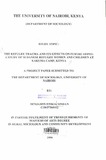| dc.description.abstract | The civil war in the Sudan which started in 1983 and ended with the signing of the peace
agreement on 9th January 2005, forced a great number of Sudanese population to flee to
the neighboring countries to seek refuge. Since 1992, majority of the Sudanese refugees
have been taking refuge at Kakuma camp in Northern Kenya, about 1000 kilometers
away from Nairobi. As civilians - largely women and children already form 90%
causalities of contemporary wars, it is presumed that the Sudanese refugee women and
children have suffered the agony of refugee life the most. Hence this study aimed at
finding out the trauma of being a refugee among the women and children who are the
majority. Secondly, the study aimed at recording their hopes for the future.
To find out the real issues affecting the lives of the Sudanese refugee women and
children at the camp, the study sought to answer three broad questions relating to the
socio-economic needs, security concerns, and hope for a better life in view of the signed
peace agreement. Three hypotheses were formulated which the study sought to test.
The study focused exclusively on the Sudanese refugee women and children at Kakuma
camp taking into account the main Sudanese regional groups/communities, namely,
Dinka Bor, Dinka Bahr-el-Ghazal, Equatoria, and Nuer communities respectively.
Samples were purposely drawn from among the refugee women in each of the main
Sudanese regional groups/communities. The over all sample size was 10'0. Various
types of data collection methods, were administered to gather both quantitative and
qualitative data.
Descriptive and inferential statistics were used-to analyze the data. The findings of the
study revealed that the Sudanese refugee women and children did not have access to
adequate socio-economic opportunities. This tended to act as a factor pushing them to
resettle overseas in order to escape the traumatic experiences in the camp. The study also
revealed that though the Sudanese refugee women and children suffered various types of
abuse in the camp, the magnitude and frequency of such incidents were in most cases
exaggerated, and, in some cases, fabricated to facilitate resettlement process. The
underlying motive remained the attempt by the women and children to resettle overseas
to escape the harsh socio-economic environment in the camp.
The study furthermore revealed that the Sudanese refugee women and children did not
fully believe that the signed peace agreement was genuine. As such they did not have a
full desire to return home at the moment since there seemed to be no prospect in sight for
an end to the situation that had forced them to flee the country. Based on the findings, several recommendations were made. The first one requested the
International Community to ensure that the government of Sudan adheres to the terms of
the peace agreement so that a conducive environment could be created in the Sudanese to
hasten the return of the refugees to rebuild their lives. | en |

